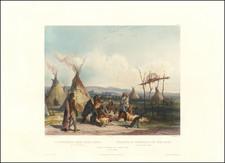Evocative Photograph of Iron Whip
On Special Card Mount of F. V. Hayden's U.S. Geological Survey
A wonderful cabinet card of Iron Whip, a member of the Ponca, a midwestern tribe forcibly removed to Indian Territory in the 1870s. Iron Whip or Wegacapi is shown seated, wearing an impressive bear claw collar, with a blanket covering his lap. This portrait was likely made by Julian Vannerson, a Washington, D.C. photographer who specialized in photographing Native American delegations who came to Washington for treaty negotiations.
Julian Vannerson
According to Merry A. Foresta (American Photographs: The First Century,1996), Adrian Vannerson was part of a systematic government effort to document members of treaty delegations who came to Washington, D.C. Area portrait studios, including that of James McClees, for whom Vannerson worked, made steady profits from the business of delegation photography. In the winter season of 1857–58 some ninety delegates from thirteen tribes were in the capital. The Amon Carter Museum has a print of this photograph which they attribute to Julian Vannerson. The museum dates the image to ca. 1858-1859.
Ferdinand V. Hayden
The present cabinet card, likely dating to the 1870s, is notable for being a part of a rare series of Native American photographs issued under the direction of Ferdinand V. Hayden, director of the U.S. Geological Survey. Hayden led the famous 1871 government expedition into the Yellowstone region of northwestern Wyoming. William Henry Jackson is often associated with Hayden do to his photographic work on the latter's survey, and some of Jackson's portraits of Native Americans are also included in the series of which the present cabinet card is a part.
Rarity
Original cabinet cards of Native Americans issued by the U.S. Geological Survey under F. V. Hayden are avidly sought and have become rare in the market.
Ferdinand Vandeveer Hayden, known to the Sioux as "man-who-picks-up-stones-running," stands among the pantheon of eminent geologists of the 19th century.
Hayden's academic career commenced at Oberlin College, and he furthered his education at Albany Medical College, where he received his M.D. in 1853. Despite his medical training, Hayden was primarily engaged in geology, a field to which he would dedicate his life's work.
Hayden commenced his geological career with a survey in the Nebraska Territory in 1856. In 1859 and 1860, he conducted further exploratory work in the Rocky Mountains, particularly in Colorado, which was then part of the Nebraska and Kansas territories. His early work in the field earned him the respect of Native American tribes, with the Sioux reportedly dubbing him "man-who-picks-up-stones-running" due to his avid and energetic collection of geological samples during his expeditions.
By the 1860s, Hayden had risen to prominence as a geologist and was appointed the United States Geologist for the Geological Survey of the Territories. This role would define his career, leading numerous surveys in the Western United States. Notably, from 1871 to 1872, Hayden led a survey into the region that would become Yellowstone National Park, and his reports significantly contributed to the establishment of Yellowstone as the first National Park in 1872.
Hayden's most significant contribution to geological literature was the Geological Atlas of Colorado, published in 1877. This work was the result of comprehensive surveys conducted across Colorado, meticulously documenting the state's geography and geology. The atlas offered detailed maps on a scale previously unseen, encompassing not only Colorado but adjacent areas, including parts of Utah, Arizona, and New Mexico.
Hayden's influence extended to academia, as he was affiliated with the University of Pennsylvania for a period, where he held the position of professor of geology. His academic and field work combined to form a substantial body of knowledge that would be used by future scholars and explorers.
Ferdinand V. Hayden passed away on December 22, 1887, in Philadelphia, Pennsylvania. His enduring legacy is reflected in the numerous natural features named after him, including Hayden Valley in Yellowstone and Mount Hayden in Colorado. His contributions to geology during the 19th century remain a cornerstone of American geological and geographical sciences.










![(Native American Photograph) [Albumen photograph print of seated Native American man]](https://storage.googleapis.com/raremaps/img/small/93105.jpg)

![[Governor of Virginia] The Right Honble William Anne, Keppel, Earl of Albermarle, Viscount Bury, Baron of Ashford, Groom of the Stole, Governour & Captn General of Virginia, Colonel of the Coldstream Regiment of Fort, Lt. General of His Majesty's Forces, Ambassador Extraordinary & Plenipotentiary to the Court of France, one of the Privy Council, & Knight of the Most Noble Order of the Garter &c.](https://storage.googleapis.com/raremaps/img/small/60432.jpg)
![(San Diego Panoramic Photograph) U.S. Marine Barracks [Panoramic photograph of San Diego Marine Corps Recruiting Depot (MCRD)]](https://storage.googleapis.com/raremaps/img/small/99633.jpg)
![(San Diego Birdseye Photograph) San Diego from Court House, Coronado and Islands in distance [Hotel del Coronado, San Diego Bay, Wharf]](https://storage.googleapis.com/raremaps/img/small/102663.jpg)